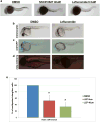DHODH modulates transcriptional elongation in the neural crest and melanoma
- PMID: 21430780
- PMCID: PMC3759979
- DOI: 10.1038/nature09882
DHODH modulates transcriptional elongation in the neural crest and melanoma
Abstract
Melanoma is a tumour of transformed melanocytes, which are originally derived from the embryonic neural crest. It is unknown to what extent the programs that regulate neural crest development interact with mutations in the BRAF oncogene, which is the most commonly mutated gene in human melanoma. We have used zebrafish embryos to identify the initiating transcriptional events that occur on activation of human BRAF(V600E) (which encodes an amino acid substitution mutant of BRAF) in the neural crest lineage. Zebrafish embryos that are transgenic for mitfa:BRAF(V600E) and lack p53 (also known as tp53) have a gene signature that is enriched for markers of multipotent neural crest cells, and neural crest progenitors from these embryos fail to terminally differentiate. To determine whether these early transcriptional events are important for melanoma pathogenesis, we performed a chemical genetic screen to identify small-molecule suppressors of the neural crest lineage, which were then tested for their effects on melanoma. One class of compound, inhibitors of dihydroorotate dehydrogenase (DHODH), for example leflunomide, led to an almost complete abrogation of neural crest development in zebrafish and to a reduction in the self-renewal of mammalian neural crest stem cells. Leflunomide exerts these effects by inhibiting the transcriptional elongation of genes that are required for neural crest development and melanoma growth. When used alone or in combination with a specific inhibitor of the BRAF(V600E) oncogene, DHODH inhibition led to a marked decrease in melanoma growth both in vitro and in mouse xenograft studies. Taken together, these studies highlight developmental pathways in neural crest cells that have a direct bearing on melanoma formation.
Figures




References
-
- Davies H, et al. Mutations of the BRAF gene in human cancer. Nature. 2002;417:949–954. - PubMed
-
- Rubinstein AL, Lee D, Luo R, Henion PD, Halpern ME. Genes dependent on zebrafish cyclops function identified by AFLP differential gene expression screen. Genesis. 2000;26:86–97. - PubMed
-
- Luo R, An M, Arduini BL, Henion PD. Specific pan-neural crest expression of zebrafish Crestin throughout embryonic development. Dev Dyn. 2001;220:169–174. - PubMed
-
- Bakos RM, et al. Nestin and SOX9 and SOX10 transcription factors are coexpressed in melanoma. Exp Dermatol. 2010;19:e89–94. - PubMed
Publication types
MeSH terms
Substances
Associated data
- Actions
- Actions
- Actions
- Actions
Grants and funding
LinkOut - more resources
Full Text Sources
Other Literature Sources
Medical
Molecular Biology Databases
Research Materials
Miscellaneous

